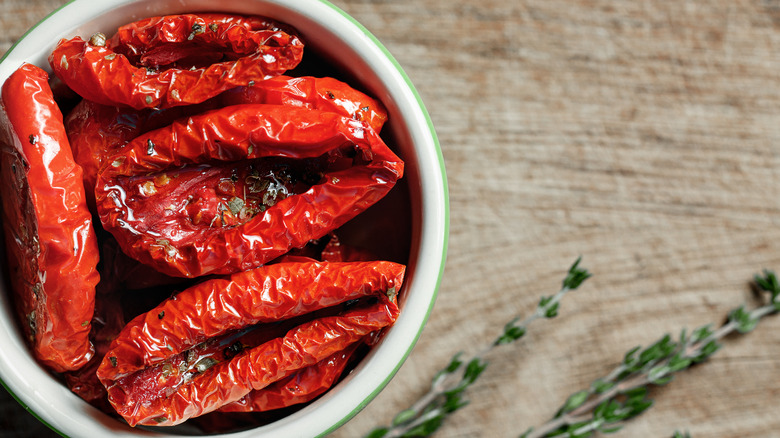The Difference Between Sun-Dried Tomatoes Packed Dry And In Oil
Sun-dried tomatoes provide an appealing punch of concentrated tomato taste. Slightly sweet, tart, and tangy, with a pleasant chewiness, their contribution is unique, and many dishes benefit from the bright component (in both taste and color). They're an indispensable pantry item for their minimal storage space and maximal flavor. Moreover, they can last for up to a year.
While the traditional method is often followed — sun-dried tomatoes eponymously describe their process — they can also be made in an oven or a dehydrator. As with many foods that have endured, they are a consequence of necessity. Their preservation by sun-drying is originally traced to Indigenous people. The plant and practice made their way from the Americas to the Mediterranean region and later into Southern Italy and onto its ceramic rooftops. Now that we can have almost anything in any season and toss what's left in the freezer, the imperatives to keep a harvest from spoiling and winter appetites satiated are hardly factors. Sun-dried tomatoes remain mostly a cook's luxury or a backyard gardener's method for making use of overabundance.
They retain a whiff of the delicacy of items distilled from large amounts, such as saffron or excellent balsamic vinegar — 20 pounds of tomatoes is reduced to one during dehydration. They're still available that way, shrunken and leathery, or they can be bought packed and plumped in oil. Though their essence is the same, the type matters a little. Mild or assertive, textural or silky, you'll want to use the right kind for your recipe.
Dry-packed sun-dried tomatoes
Dry-packed sun-dried tomatoes are typically found in bags in the produce department at the grocery store. In a coop, they may be sold as a bulk item as well. They're highly flavored and textured, just like other dehydrated fruits. While they can feel like a bit of a splurge, they absorb liquid during reconstitution, so a small amount will go farther than it appears. You can keep them in an air-tight container in a dry, cool pantry for up to a year, making them an effortless resource to have on hand.
Before using them, you should rehydrate dry-packed sun-dried tomatoes in salted liquid for about an hour. You can bring that time down to 10 minutes with a zap in the microwave, according to America's Test Kitchen. The soaking liquid can be reserved and later incorporated into the recipe with no straining required. The one exception to prior rehydration is when sun-dried tomatoes are going into a sauce or stock, provided they're given ample time to soften. It's easiest to slice them once hydrated, however. If it's intended they plump during cooking, you may want to cut them first — kitchen scissors work well for the task.
Dry-packed sun-dried tomatoes work great in grain and pasta salads. Mediterranean Orzo and other Mediterranean-inspired dishes are a fitting place to feature them. They shine on pizza and focaccia as a foil to a yeasted or sourdough bread component. Or add them straight to creamy sauces — a green, such as kale or spinach, offers a gorgeous color complement.
Oil-packed sun-dried tomatoes
Oil-packed sun-dried tomatoes are simply sun-dried tomatoes that have been vacuum sealed in jars of oil, frequently with herbs or garlic added. You can find them in the canned foods and vegetables aisle of the supermarket. They are both more unctuous and more expensive than the dry-packed type. With some restraint, the oil itself, which has taken on much of the jammy tomato flavor, can be a delicious ingredient in sauce and salad dressings or used to lightly sauté aromatics. Likewise, drizzle it over a serving of pasta or bean stew to add richness and vibrancy. And it's a delicious method for providing moistness and adding a sweet kick to turkey and chicken burgers.
And because they are already softened, oil-packed sun-dried tomatoes don't require any preparation before use. Depending upon the recipe, you may want to drain them of their excess oil or cut them into smaller pieces. However, it's not always necessary. They disappear cunningly into silky red sauces and stud baked pasta or rice dishes with their assertive zip. Diced and fortified with capers and garlic, they're an instant bruschetta topping or can be lovely stirred into dips and spreadable cheeses.
Once opened, commercially prepared oil-packed sun-dried tomatoes last in the refrigerator for up to six months. The cold causes the oil to become opaque, but it melts when it reaches room temperature. As the quality can differ, consider checking the ingredients or selecting an option from a better brand.
Are they interchangable?
Although both kinds of sun-dried tomatoes are nearly interchangeable, the oil-packed one offers richer fattiness in a recipe and on the tongue. The desired mouthfeel of the finished dish is contingent upon the variety and will factor into which one is optimal. For example, a buttery grilled cheese might benefit from the lighter dry-packed version, whereas a Spinach and Tomato Stuffed Chicken Breast could use some oiliness. Some contend that oil-packed tomatoes retain more flavor, and of course, they'll absorb any of the seasonings they're jarred with. Sun-dried tomatoes are abundant in vitamin C, fiber, and the antioxidant lycopene — the fat and caloric content increases with the oil-packed one.
The substitution of one for the other will be most successful in recipes where they are neither a star ingredient, have plenty of cooking time to mute any opposing characteristics or are fully incorporated into a stew or sauce, such as in Pesto Rosso. That said, either type of sun-dried tomato can be used to contribute unique umami and tartness without a significant downside in the swapping — it's certainly better to use the one at hand than none at all. Important considerations might center around the nutrition, cost, and storage of the product instead, which is notably higher, longer, and less expensive for dry-packed tomatoes. Either way, sun-dried tomatoes add value to the kitchen toolbox.



